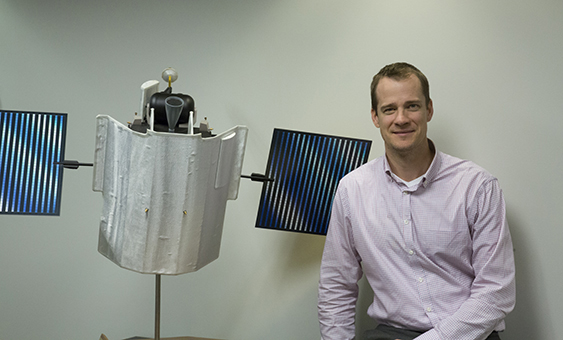Press Release
APL Engineer Named First Recipient of New Heinlein Award
Tue, 10/07/2014 - 12:25

Credit: Johns Hopkins APL
Daniel O’Shaughnessy, an engineer at the Johns Hopkins University Applied Physics Laboratory (APL) in Laurel, Maryland, has been named the first recipient of the Heinlein Award for his development of a spacecraft navigational technique that makes use of solar radiation pressure to control a spacecraft.
The Robert A. and Virginia Heinlein Prize Trust, a nonprofit foundation promoting the commercial uses of space, created the Heinlein Award to recognize space-tested technologies that can benefit commercial space activities.
O’Shaughnessy employed the award-winning technique — known as solar sailing — while Guidance and Control Lead Engineer for the MErcury Surface, Space Environment, Geochemistry, and Ranging (MESSENGER) mission. The team relied on six planetary gravity assists to enable Mercury orbit insertion, but solar radiation pressure was considered a threat to the success of these maneuvers.
“Because of the changing proximity to the Sun during MESSENGER’s cruise phase, the [solar radiation pressure] varied from one to 11 times the value experienced at Earth,” explained O’Shaughnessy, who now serves as MESSENGER’s Mission Systems Engineer. This variation in magnitude, as well as the attitude-dependent direction of the resulting disturbance force and torque, presented a significant challenge to mission designers, navigators and the guidance and control team, he said.
“Those flybys were designed to take MESSENGER within 200 kilometers of the planet, so precision targeting was absolutely critical,” he said. “If we flew too low, the probe could crash into Mercury; overshoot the planet and MESSENGER would have had to use its reserve fuel to correct for the acceleration loss. Either way, getting off target for any one of these flybys threatened to jeopardize the success of the mission.”
Ultimately, the team found a way to use the solar radiation pressure to their advantage by using the light pressure on its solar panels to perform fine trajectory corrections on the way to Mercury. By changing the angle of the solar panels relative to the Sun, the amount of pressure was varied to adjust the spacecraft trajectory more delicately than possible with thrusters. Minor errors are greatly amplified by gravity assist maneuvers, so using radiation pressure to make very small corrections saved propellant, and helped to extend the life of the mission.
“This work exemplifies the teamwork that has made the MESSENGER mission a success,” said Mike Ryschkewitsch, head of APL’s Space Exploration Sector. “Modifying the trajectory via solar sailing instead of thruster burns required tight coupling of mission designers, navigators, guidance and control engineers and the spacecraft operations team. Active participation from each of these team members was essential to achieving the paradigm shift.”
Heinlein Prize Trust Trustee Arthur M. Dula said, in a statement, “The Heinlein Award recognizes demonstration in space of important technical accomplishments that benefit commercial activities.”
“While most commercial endeavors are not planning interplanetary trajectories, the demonstration of this capability has applications closer to home,” O’Shaughnessy noted. “Many Earth-orbiting missions require precision orbit control and could potentially use this technique to provide very accurate orbit maintenance without requiring expensive onboard propellants.”
O’Shaughnessy will receive a diploma and monetary award at a recognition dinner at the Air and Space Museum in Washington, D.C., on Nov. 21.